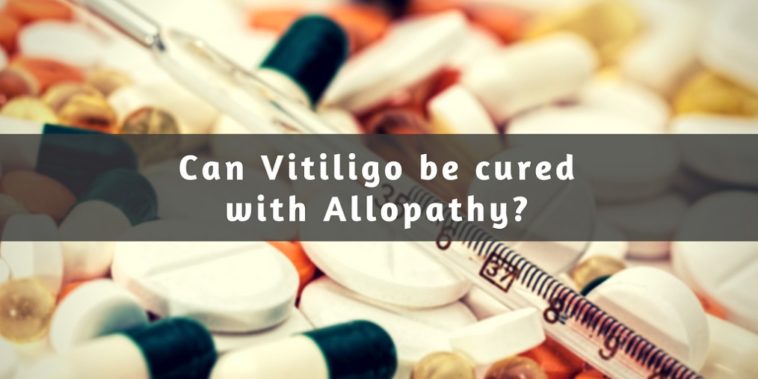Allopathic treatment for vitiligo attempts to stop the melanin destruction and reverse the damage as far as possible. Various allopathic medicines for vitiligo are approved by local governments across the world and are relatively costlier compared to homeopathy and herbal medicines. Side effects of these medicines are reported often in form of itching, rashes and skin thinning.
The impact of the treatment may vary from one individual to another. While many people recover completely from vitiligo (particularly if treated during the early stage), some notice no sign of improvement. In fact, many people have reported that the improvement was temporary and their vitiligo came back once treatment was stopped.
A detailed history is required by a practitioner to decide dosage and proportion of allopathic medicine. If vitiligo is extensive, treatment may need one year or more to restore earlier appearance. The success of treatment depends on the extent of vitiligo patches and various other factors.
How does allopathic treatment for vitiligo work?
Allopathy treats vitiligo by conventional means, i.e. with drugs having effects opposite to the symptoms. At times, the underlying cause of the problem is identified to regulate immunity. The initial treatment aims at stopping or slowing down the further destruction of melanocytes, and once vitiligo is stable, the medicines attempt to stimulate the melanocyte function to melanin again. Result? The skin starts turning brown. Big patches need more days to recover while small spots repigment faster. Just like any other line of treatment, allopathy faces difficulty to cure generalized-extensive vitiligo and white patches around the lips, on the fingertips and toes.
Most prescribed allopathic medicines for vitiligo
Allopathic treatment of vitiligo offers two approaches to vitiligo management – protection of depigmented patches and repigmentation therapies.
For each approach, medicines or tropical applications are prescribed after skin biopsy and blood draws (vary from person to person, depending on associated symptoms). Based on the location, duration, and extent of spread of the patches, drugs are prescribed. The patient’s general wellbeing and the presence of thyroid disorders, or auto-immune diseases can impact the effectiveness or selection of drugs.
There are several allopathic medicines, and topical creams which are often indicated for the treatment of vitiligo. These include:
Creams
Applying a corticosteroid cream to white patches may help return color, particularly if used early in the skin disorder. Side effects include skin thinning, streaks or lines on the skin. Milder forms of the drug may be prescribed for children with vitiligo and those with extensive vitiligo.
Medications
Ointments containing tacrolimus or pimecrolimus (calcineurin inhibitors) can be effective for people with small white patches, particularly on the face and neck. The treatment may have less side effects than corticosteroids and is often used alongside ultraviolet B (UVB) light therapy. Since such medications affect the immune system, the Food and Drug Administration (FDA) has warned about a possible link between them and skin cancer.
Along with above-mentioned medications, Prostaglandin E2 (applied to the skin as a gel, to restore skin color in people with localized vitiligo) and Tofacitinib (an oral drug typically used to treat rheumatoid arthritis) are being tested for vitiligo treatment.
Therapies
This treatment approach combines psoralen (plant-derived substance) with light therapy. Psoralen is consumed or applied to the affected skin, before exposing the affected area to ultraviolet A (UVA), UVB light or excimer light. So far, these approaches have yielded better results than just medication. One may need to repeat the process up to three times a week for six to 12 months.
Things to do to yield best results
The scope of any vitiligo treatment extends beyond the physical symptoms of the chronic skin disorder. To address the underlying mental stress and depression, adopt a holistic approach. Make sure to:
- Expose the white patches to the early morning sun for 20-30 minutes on daily basis.
- Use a mild soap for bathing.
- Avoid synthetic clothes (made by chemicals).
- Avoid stress and keep a positive attitude.
Note: Avoid self-medication with any of the medicines mentioned or external applications above. Always consult a healthcare professional before starting with any line of treatment.

